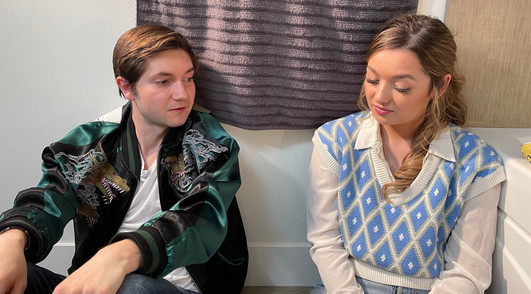Review of the Movie “Party Quest”

The film begins with shots of items in the bedroom (toys, pictures, posters). The main character is immediately introduced and the narrator talks about her. As the narrator speaks, the strengths and weaknesses of the character are shown. This is a cheerful start to a movie that will gradually build its tone and be witty. The narrator says that the hero of this story has not left his house for months and it read on screen that: “Strengths: A+ Student and Godzilla Connoisseur, Weaknesses: Hates Social Gatherings.” Many movies use dialogue between characters to introduce the hero, but in some movies, it is through seeing the hero's behavior in their daily life that we get to know them. However, here the filmmaker introduces the character directly to us in a cute and interesting way. They talk about his strengths and weaknesses, as well as his inner feelings. We learn more about his inner feelings when the narrator's voice changes to the hero's inner voice. A voice that talks to himself, struggles with his decisions, and wanders around. The film can also be noticed for its use of different narrative techniques. It uses these techniques to prevent its audience from getting bored. The inner voice not only talks about courage in life with the hero but even suggests what outfit to wear for a party!
The fact that a filmmaker with such a topic, namely the courage of hero to attend a party, has taken the risk of making a movie is in itself a risk. The subject can easily turn into something boring or childish and discourage the audience from watching. However, the filmmaker cleverly turns this risky subject into their strength. After the opening scene in the hero's bedroom and the inner voice conversation with himself, it's interesting for us to know whether she will eventually go to the party or not. Can a boy who is so averse to crowds, people, parties, gatherings, and any social interaction convince himself to attend this party? The focus of the film in the first half is on the psychology of the character and it advances the story through this psychology. While we empathize with the hero and feel sorry for her, we want to examine him as an example of shy and anti-social personalities. We want to understand what goes on in the mind of such people and why they avoid crowds. Because knowing them is also knowing ourselves. In each of us, there is a part of this shyness hidden.

The screenplay has a unique and captivating idea for each section. From the first three minutes, it introduces us to the hero of the story, Austin, with his temptations and obsessions, his desire to attend the party, and his fear of the crowd he will face at the party. As a result, by the time Austin reaches the entrance of the party, we almost know him and what kind of person he is. The screenwriter creates a character that is familiar to the audience without going towards the familiar types of characters. We have seen similar people like Austin in our lives. When the screenplay feels that three minutes of focusing on the main character are enough, it introduces a new character. A girl named Lex, who is the same age as Austin and has weaknesses and strengths just like him, is introduced. Therefore, it is because of Lex's arrival that Austin invites himself to the party. At this point, the party itself is expanded, and we see the environment through Austin's eyes. Seeing the environment from his perspective makes us familiar with his way of thinking and helps us understand how terrifying a party can be for someone like him. A place where everyone is a stranger, no one looks at you, and you feel out of place.

Now it's the screenwriter's turn to play a trick and introduce a rival character. A character who has no name and is referred to as the sarcastic Hot Guy! Someone who can talk to girls just the opposite of Austin and doesn't seem shy or introverted. The filmmaker creates a hypothetical triangle in the audience’s mind, just like a triangle that leads to Austin's possibilities. The film introduces us to the environment of this party with precision and obsession. We get to know different characters who are there and understand why someone like Austin doesn't enjoy social connections and prefers not to attend parties. The filmmaker works meticulously and skillfully in developing the characters and even introduces peripheral and not-so-vivid characters, creates the environment and puts his hero in the midst of a series of comic and agonizing situations. The film uses dialogue between people, Austin's conversation with his conscience, narrator narration, and even silence to create a believable situation that seems simple. It should be noted that although the presence of a shy person at a party is inherently risky, creating the party environment in a realistic way is not easy. The successful filmmaker manages to bring out a tangible subject from the heart of the teenage world and by focusing on qualities that are understandable at any age, such as shyness and lack of social skills, makes a film appealing to all ages.















Comments